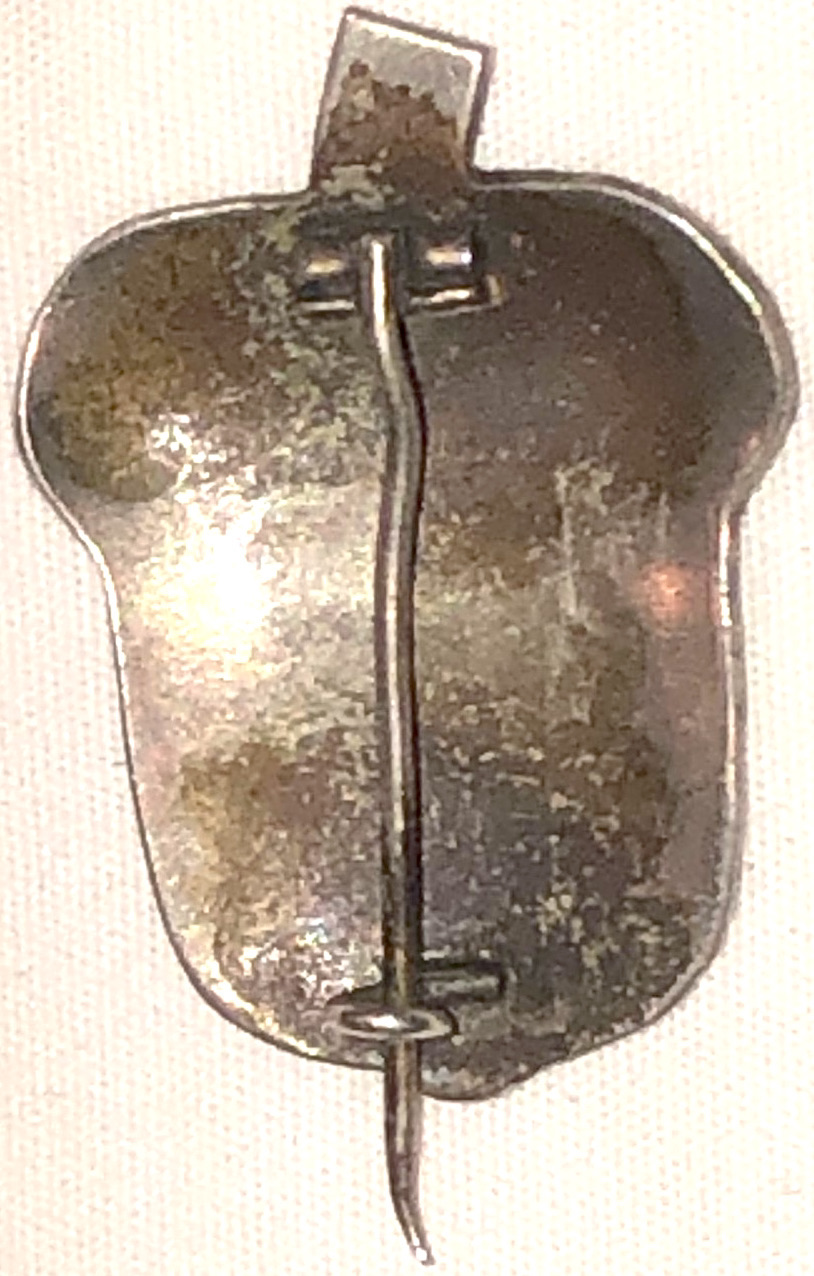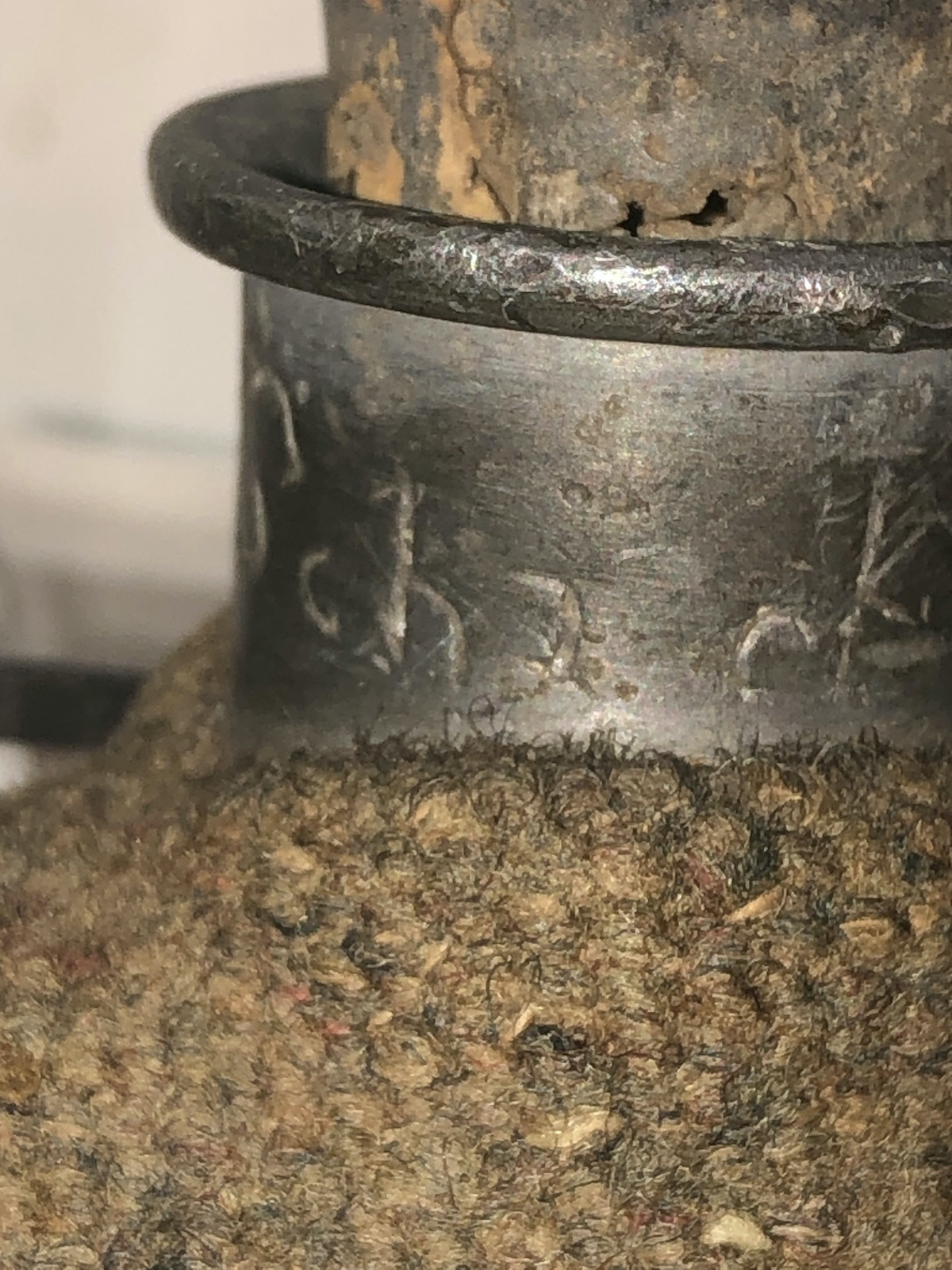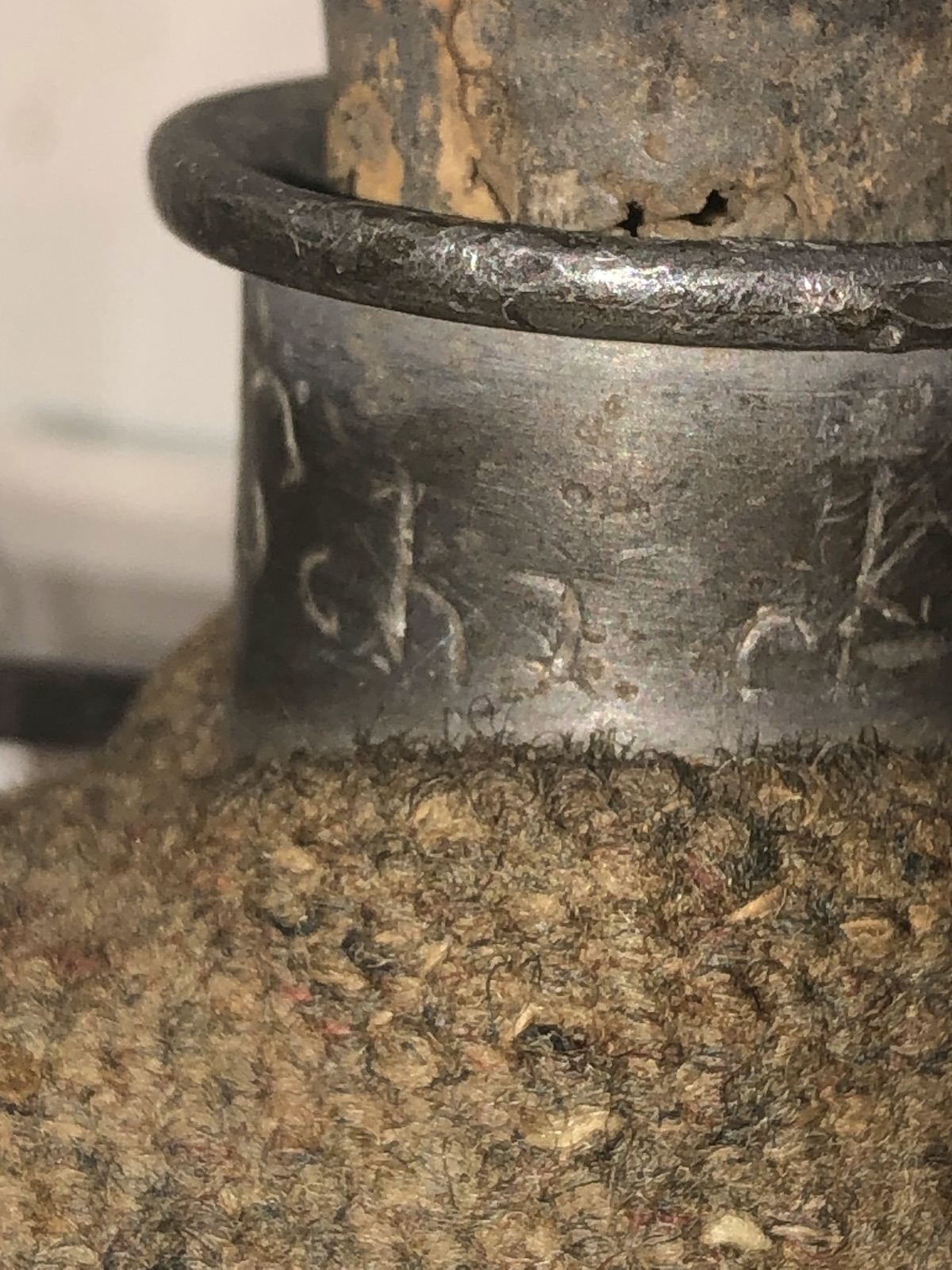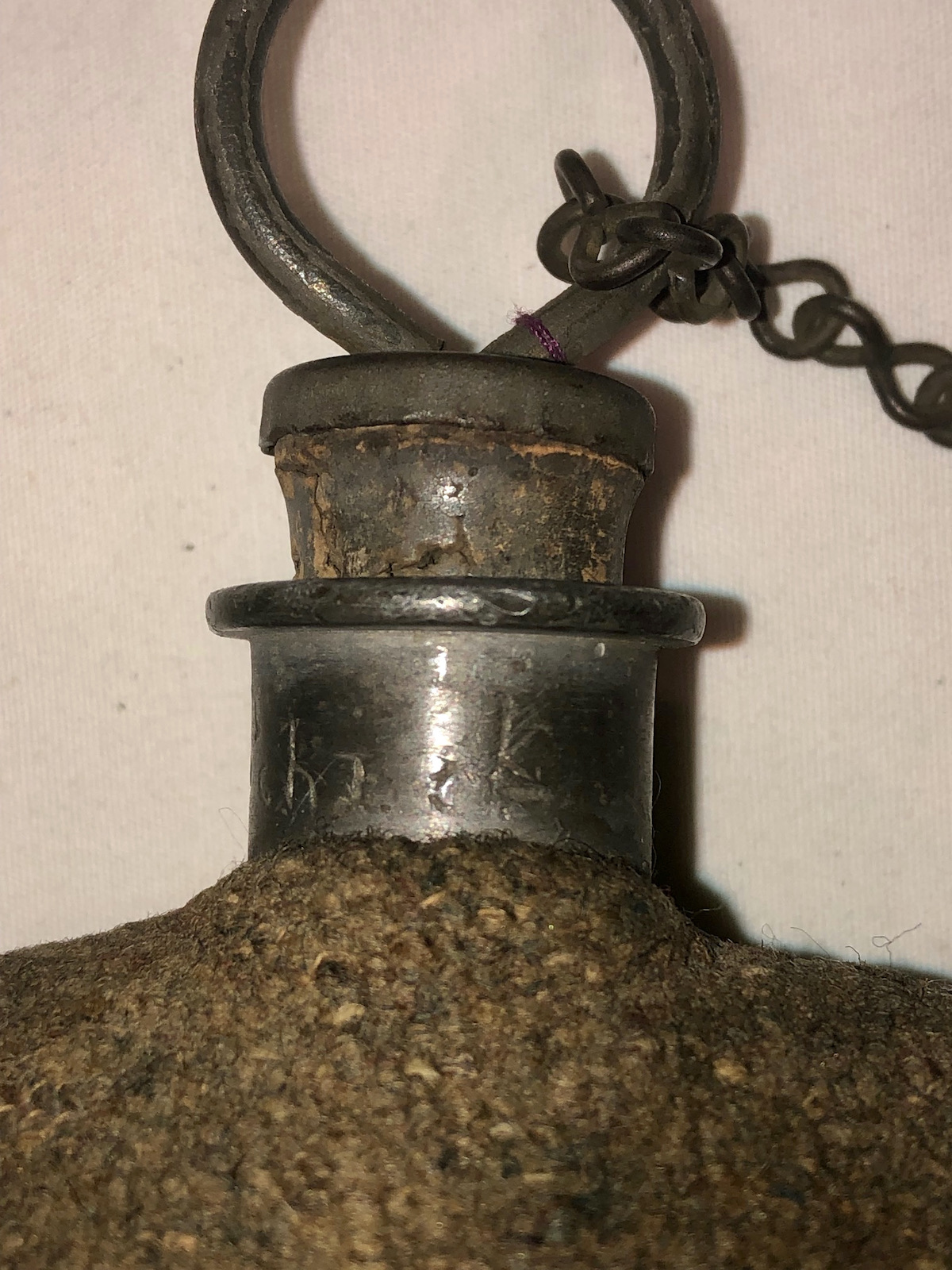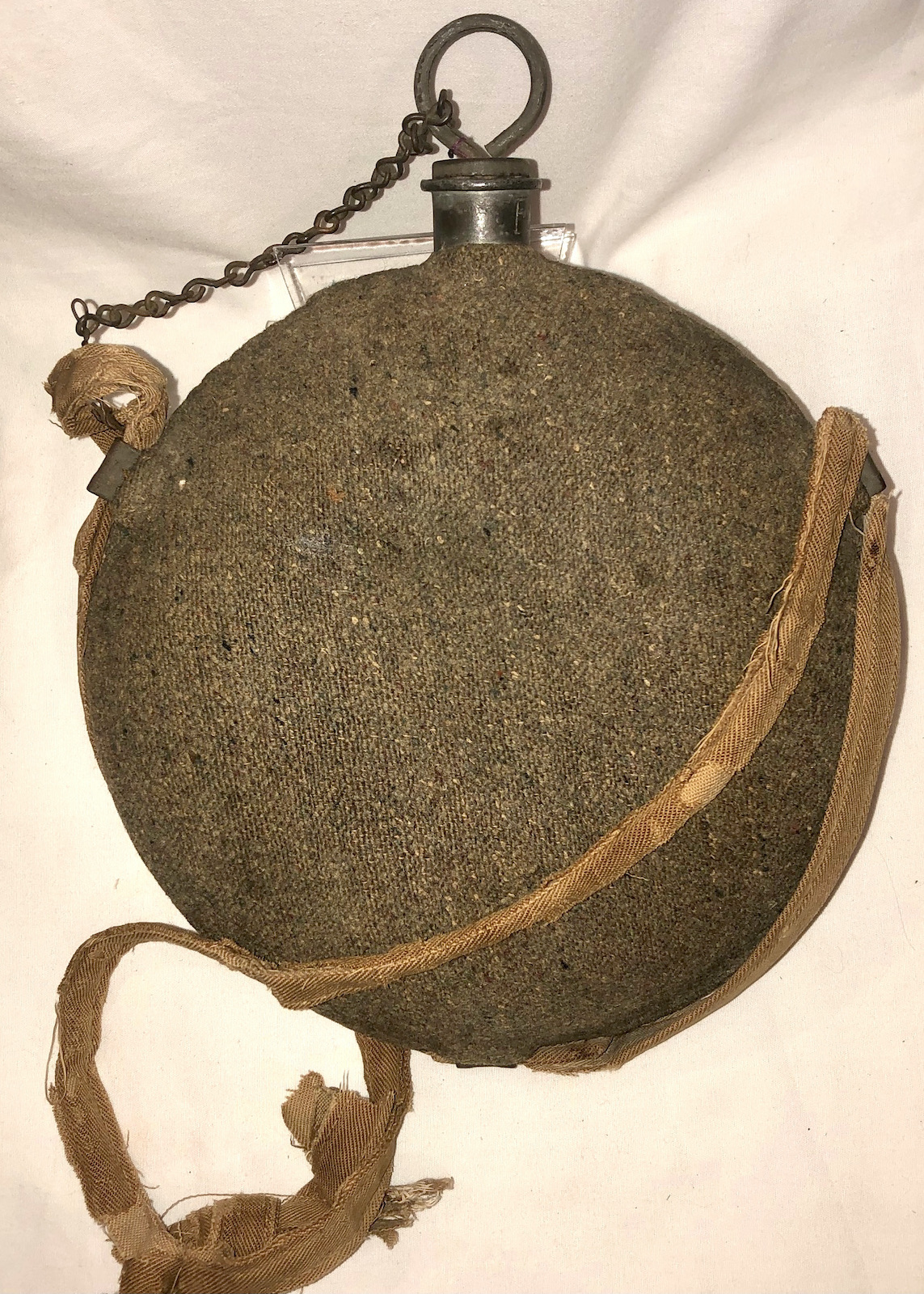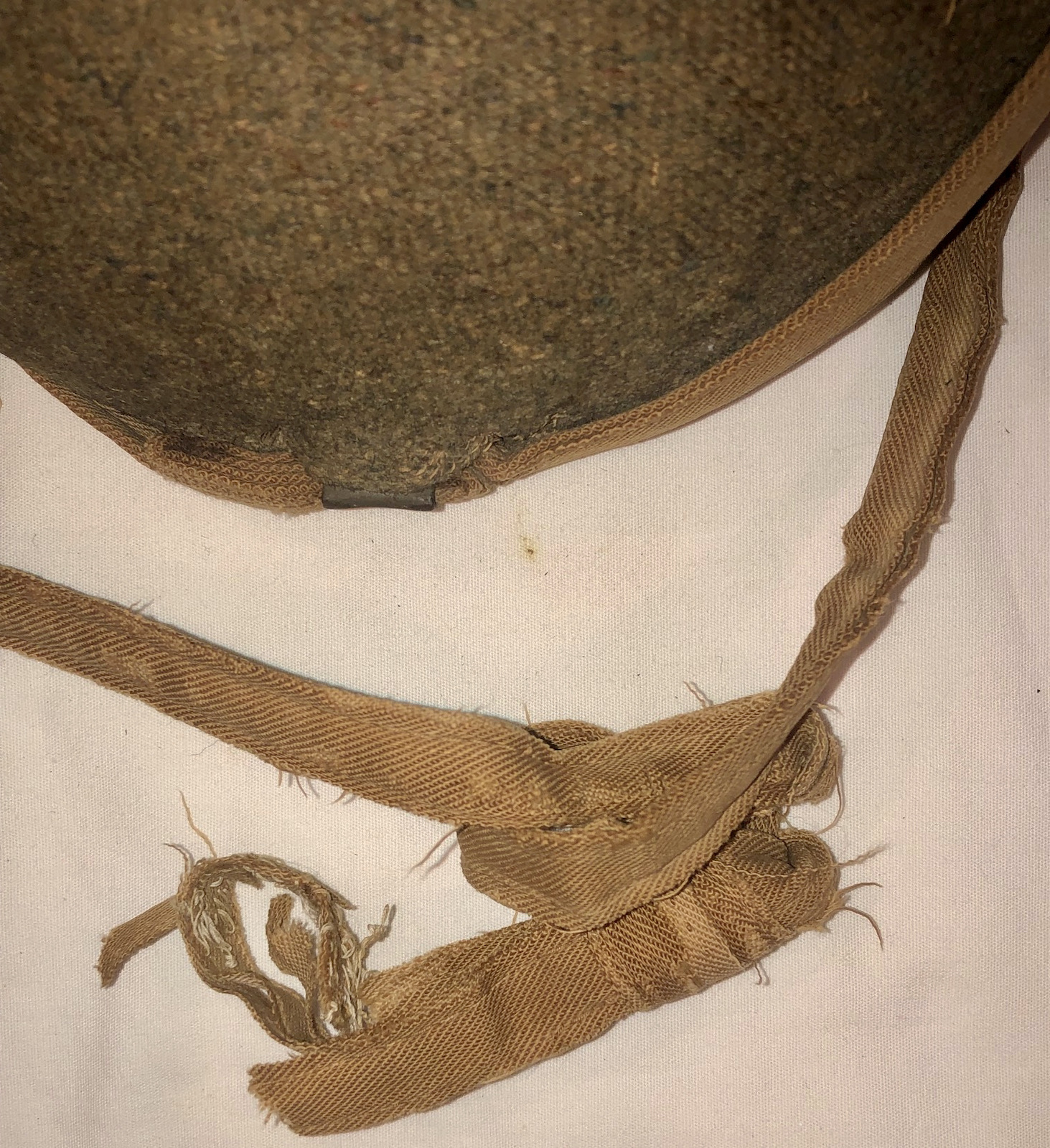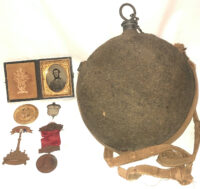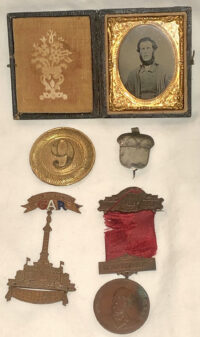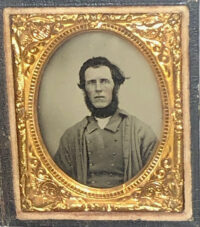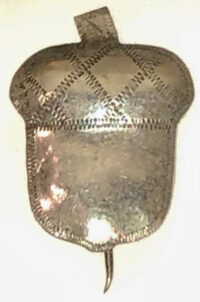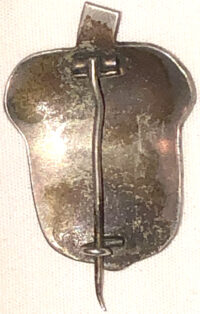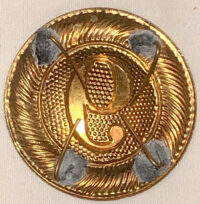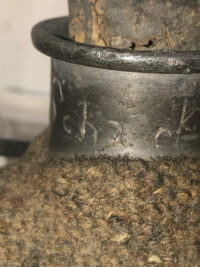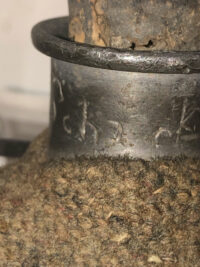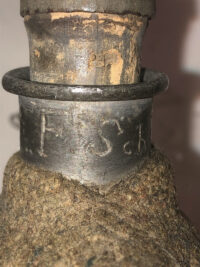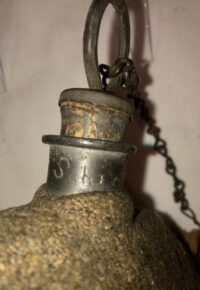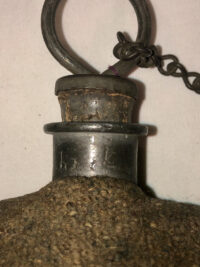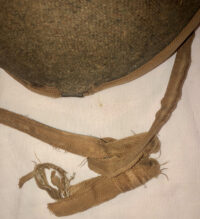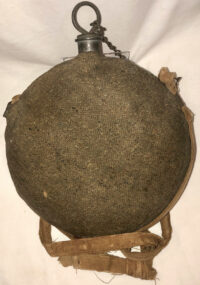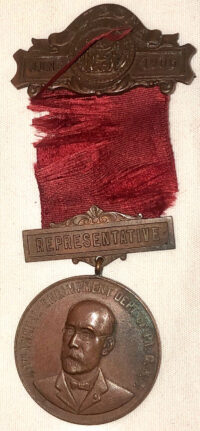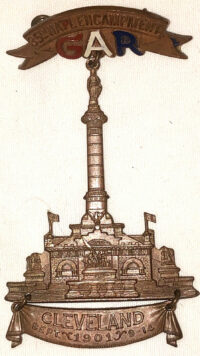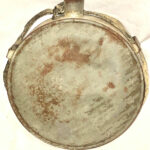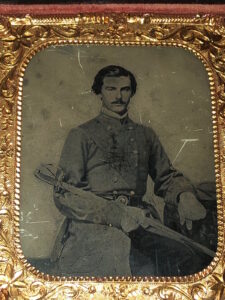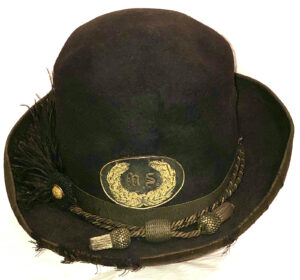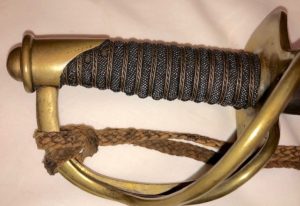Id’d M1858 Smoothside Canteen, 14th Corps Badge, Ruby Ambrotype, Shako Rosette, Reunion Medals – Private Frank Schick Co. E 9th Ohio Infantry
SOLD
Id’d M1858 Smoothside Canteen, 14th Corps Badge, Ruby Ambrotype, Shako Rosette, Reunion Medals – Private Frank Schick Co. E 9th Ohio Infantry – This grouping contains a M1858 canteen, with its original sling and stopper; the mouthpiece has carved into the soft pewter the name “F. Schick”. Frank Schick enlisted in April or May, 1861 into Co. E of the 9th Ohio Infantry, a regiment composed primarily of men of German descent; between 1836 and 1860, four German militia regiments formed in Cincinnati. At the onset of the Civil War, many of these men would join the newly formed 9th Ohio, the first nearly all German regiment to join the Union Army. Frank Schick and his fellow soldiers of German descent would see action at Rich Mountain, Mill Springs, Shiloh, Corinth, Perryville, Chickamauga, Chattanooga, the Atlanta Campaign and Resaca. Private Schick was wounded at the Battle of Chickamauga, mustering out of the service in June, 1864.
Accompanying the canteen are the following: a 1/9 plate, ruby ambrotype of Schick, wearing a militia style, fireman’s shirt, under a military sack coat (the image is contained in a full case); a pre-war, militia shako, circular, sheet brass disk with a raised number “9”; a silver, 14th Corps acorn with a T-pin attachment mode (badge measures – 1.5″ x 1″); two post-war, GAR and reunion medals. All of the accompanying items remain in excellent condition with the exception of the reunion medals, which are in fair condition. The grouping was found in a rural, Ohio house, over 50 years ago.
Frank Schick
| Residence was not listed; 23 years old. Enlisted on 4/22/1861 as a Private. On 5/8/1861 he mustered into “E” Co. OH 9th Infantry He was Mustered Out on 5/27/1861 He also had service in: “E” Co. OH 9th Infantry (3 years) |
Frank Schick
| Residence was not listed; 22 years old. Enlisted on 5/27/1861 as a Private. On 5/27/1861 he mustered into “E” Co. OH 9th Infantry He was Mustered Out on 6/7/1864 He was listed as: * Wounded 9/20/1863 Chickamauga, GA |
Frank Schick
| Name | Frank Schick |
| Enlistment Age | 23 |
| Birth Date | abt 1838 |
| Enlistment Date | 22 Apr 1861 |
| Enlistment Rank | Private |
| Muster Place | Ohio |
| Muster Company | E |
| Muster Regiment | 9th Infantry |
| Muster Regiment Type | Infantry |
| Muster Information | Enlisted |
| Muster Out Date | 27 May 1861 |
| Muster Out Information | Mustered Out |
| Side of War | Union |
| Survived War? | Yes |
| Additional Notes 2 | Muster 2 Date: 08 May 1861; Muster 2 Place: Ohio; Muster 2 Unit: 1943; Muster 2 Company: E; Muster 2 Regiment: 9th Infantry; Muster 2 Regiment Type: Infantry; Muster 2 Information: Enlisted; |
9th OH Infantry
( 3-years )
| Organized: Camp Dennison, OH on 6/1/61 Mustered Out: 6/7/64 at Camp Dennison, OHOfficers Killed or Mortally Wounded: 6 Officers Died of Disease, Accidents, etc.: 2 Enlisted Men Killed or Mortally Wounded: 85 Enlisted Men Died of Disease, Accidents, etc.: 60 (Source: Fox, Regimental Losses) |
| From | To | Brigade | Division | Corps | Army | Comment |
| Jul ’61 | Jul ’61 | McCook’s Advance | Army of Occupation West Virginia | |||
| Jul ’61 | Sep ’61 | 3 | Army of Occupation West Virginia | |||
| Sep ’61 | Oct ’61 | McCook’s | Army of Occupation West Virginia | |||
| Oct ’61 | Nov ’61 | 2 | Dist of Kanawha | Department of Western Virginia | ||
| Nov ’61 | Dec ’61 | 3 | Army of Ohio | |||
| Dec ’61 | Sep ’62 | 3 | 1 | Army of Ohio | ||
| Sep ’62 | Nov ’62 | 3 | 1 | 3 | Army of Ohio | |
| Nov ’62 | Jan ’63 | 3 | 3 | Centre, 14 | Army of Cumberland | |
| Jan ’63 | Oct ’63 | 3 | 3 | 14 | Dept and Army of Ohio and Cumberland | |
| Oct ’63 | May ’64 | 2 | 3 | 14 | Dept and Army of Ohio and Cumberland | Mustered Out |
The 9th Ohio Infantry Regiment was an infantry regiment that was a part of the Union Army during the American Civil War. The members of the regiment were primarily of German descent and the unit was the first almost all-German unit to enter the Union Army.
Organization
Between 1836 and 1860, four German militia units had been formed in Cincinnati, Ohio. In 1861, in response to a call to arms by President Abraham Lincoln and subsequently by Ohio Governor William Dennison, these units swelled with hundreds of volunteers. Gustav Bergmann, a Cincinnati public school teacher, was the first volunteer to join the unit. The city of Cincinnati gave $250,000.00 for the organization of this unit. Nearly 1,500 men, mostly of German descent, volunteered for the 9th Ohio Infantry Regiment in the first three days. Col. Robert L. McCook, a local lawyer, trained and drilled the new soldiers at Camp Harrison and Camp Dennison, both near the city.
OHIO
NINTH INFANTRY
(Three Years)
| Ninth Infantry. – (Three Years’ Service.) Cols., Robert L. McCook, Gustave Kammerling; Lieut.-Cols., Charles Sondershoff, Charles Joseph, Frederick Schraeder; Majs., August Willich, Bartholomew Benz. This regiment was organized at Camp Denni- son, from May 27 to June 13, 1861, to serve for three years. It was mustered in with 1,035 officers and men, exclusive of the band, which consisted of 24 musicians. Its first engagement was at Rich Mountain, W. Va., where it sustained a loss of 1 killed and 2 wounded. At Carnifix ferry it lost 2 killed and 8 wounded. It participated in the battle of Mill Springs, Ky., and made a decisive charge, completely routing the Confeder- ates. At Chickamauga, on the second day of the battle, the regiment participated in the famous bayonet charge of Van Derveer’s brigade, and in the afternoon, while holding the hill on which the right of Gen. Thomas’s corps rested, it once more drove the Confederates back at the point of the bayonet. Its loss in the two days, battle was equal to one-third the loss of the entire brigade. It went into action about 500 strong and lost in killed, wounded and missing, 11 officers and 237 en- listed men. The regiment participated in the battle of Resaca, Ga., and on May 20 entered upon its last march against the en- emy, moving from Kingston to the Etowah river. As its term of service expired on May 27, 1864, it was ordered to Ohio for muster-out. Up to the last moment it stood within range of the enemy’s guns, being relieved from the very outer picket line by Gen. Thomas in person, and started for Cincinnati. All along the road stood their fellow-soldiers who cheered most heartily as the regiment moved away, and not any less hearty were the farewells returned by the boys of the 9th Ohio. The regiment received an enthusiastic reception at Cincinnati and was mus- tered out at Camp Dennison on June 7, 1864.
9th Regiment, Ohio InfantryOVERVIEW: Organized at Camp Dennison, Ohio, May 27 to June 13, 1861. Ordered to West Virginia June 16. Attached to 3rd Brigade, Army of Occupation, W. Va., to August, 1861. 2nd Brigade, Kanawha Division West Virginia, to November, 1861. 3rd Brigade, Army Ohio, to December, 1861. 3rd Brigade, 1st Division, Army Ohio, to September, 1862. 3rd Brigade, 1st Division, 3rd Corps, Army Ohio, to November, 1862. 3rd Brigade, 3rd Division, Center 14th Army Corps, Army of the Cumberland, to January, 1863. 3rd Brigade, 3rd Division, 14th Army Corps, to October, 1863. 2nd Brigade, 3rd Division, 14th Army Corps, to May, 1864. SERVICE: West Virginia Campaign July 6-17, 1861. Battle of Rich Mountain July 10. Capture of Beverly July 12. Duty at New Creek till August 27. At New River till November 24. Moved to Louisville, Ky., November 24-December 2, thence to Lebanon, Ky., and duty there till January, 1862. Advance to Camp Hamilton January 1-17. Battle of Mill Springs January 19-20. March to Louisville, Ky., thence moved to Nashville, Tenn., via Ohio and Cumberland Rivers February 10-March 2. March to Pittsburg Landing, Tenn., March 20-April 7. (Presented by ladies of Louisville with a National flag for gallantry at Mill Springs.) Advance on and siege of Corinth, Miss., April 29-May 30. Ordered to Tuscumbia, Ala., June 22, and duty there till July 27. Moved to Decherd, Tenn., July 27, thence march to Louisville, Ky., in pursuit of Bragg August 21-September 26. Pursuit of Hood into Kentucky October 1-15. Battle of Perryville, Ky., October 8. March to Nashville, Tenn., via Bowling Green, Lancaster, Danville and Lebanon October 16-November 7. Duty at South Tunnel opening communications with Nashville November 8-26. Guard fords of the Cumberland till January 14, 1863. Duty at Nashville, Tenn., January 15-March 6. Expedition toward Columbia March 6-14. Moved to Triune and duty there till June. Franklin June 4-5. Middle Tennessee or Tullahoma Campaign June 23-July 27. Occupation of Middle Tennessee till August 16. Passage of the Cumberland Mountains and Tennessee River and Chickamauga (Ga.) Campaign August 16-September 22. Battle of Chickamauga, Ga., September 19-21. Siege of Chattanooga, Tenn., September 24-November 23. Reopening Tennessee River October 26-29. Brown’s Ferry October 27. Chattanooga-Ringgold Campaign November 23-27. Battles of Orchard Knob November 23. Mission Ridge November 24-25. Demonstration on Dalton, Ga., February 22-27, 1864. Tunnel Hill, Buzzard’s Roost Gap and Rocky Faced Ridge February 23-25. Reconnaissance from Ringgold toward Tunnel Hill April 29. Atlanta (Ga.) Campaign May 1-25. Demonstration on Rocky Faced Ridge May 8-11. Battle of Resaca May 14-15. Advance on Dallas May 18-25. Left front May 25. Mustered out at Camp Dennison, Ohio, June 7, 1864, expiration of term. Regiment lost during service 6 Officers and 85 Enlisted men killed and mortally wounded and 2 Officers and 60 Enlisted men by disease. Total 153. 9th Ohio Infantry In the American Civil War, Ohio provided the federal government with 260 regiments of men, including infantry, artillery, and cavalry units. Ohioans also served in several other regiments from other states, most notably from Kentucky, West Virginia, and Massachusetts, as well as in federal units. Almost 330,000 Ohio men, including 5,092 African Americans, served in the Union military during the conflict. Infantry regiments formed in Ohio became known as regiments of Ohio Volunteer Infantry. They served for varying lengths of time, averaging one hundred days to three years. On June 1, 1861, the 9th Regiment Ohio Volunteer Infantry organized at Camp Dennison, just north of Cincinnati, Ohio. The 9th Regiment had previously organized for three months service, but officials requested that the regiment’s members reenlist for three years service. The 9th Regiment was the first Ohio regiment to enlist for three years service. On June 16, 1861, the 9th departed Camp Dennison for western Virginia, arriving at Webster, in modern-day West Virginia, on June 20. The regiment then advanced with the rest of General George McClellan’s force against Confederates in western Virginia. The 9th advanced to Middle Fork Bridge via Philippi and Buckhannon. At Middle Fork Bridge, Union forces drove Confederate pickets from the community. The Northerners advanced to Rich Mountain, where the Battle of Rich Mountain occurred. The Union soldiers drove the Confederates from the battlefield, with the 9th having one man killed and two wounded. The Northerners pursued the Confederates into Tygart’s Valley and traveled through Beverly and Huttonsville to Cheat Mountain. Officials soon ordered the 9th to return to Beverly and quickly dispatched the regiment to New Creek, Maryland, where it arrived on July 27. At New Creek, the 9th performed garrison duty and had detachments at New Creek, Cumberland, Maryland, and at a railroad bridge over the Potomac River three miles from New Creek. At this time, officials also brigaded the 9th with the 4th Regiment Ohio Volunteer Infantry, the 8th Regiment Ohio Volunteer Infantry, and a battery from the Fourth United States Artillery. On August 22, authorities ordered five companies from the 9th to return to Huttonsville, Virginia (modern-day West Virginia). From Huttonsville and nearby Elkwater, these companies advanced with other Union forces to Frenchtown, Virginia and then to Bulltown, Virginia (both in modern-day West Virginia). At Bulltown, the five companies from the 9th reunited with the remaining companies left at New Creek. Officials had ordered these other companies to leave New Creek for Bulltown on August 27. These companies traveled through Clarksburg and Weston, Virginia (both in modern-day West Virginia), arriving at New Creek on September 2, 1861. The 9th then advanced to Sutton, Virginia (modern-day West Virginia), where the regiment was brigaded with the 28th Regiment Ohio Volunteer Infantry, the 47th Regiment Ohio Volunteer Infantry, and a company of Chicago, Illinois dragoons. On September 7, 1861, the Union forces at Sutton advanced to Summerville, Virginia (modern-day West Virginia), arriving and engaging a detachment of Confederate cavalry on September 10. The Northerners drove the Confederates from the battlefield and pursued them to Carnifex Ferry, where the Battle of Carnifex Ferry erupted. The Union soldiers forced the Southerners to retreat, with the 9th having two men killed and eight wounded. The Northerners pursued the Confederates as far as Big Sewell Mountain before retiring to near Gauley Bridge, Virginia (modern-day West Virginia). The 9th encamped along the New River at Camp Anderson. During the remainder of September and October 1861, the regiment participated in several skirmishes with Confederate forces, with the 9th having several men killed and wounded. On November 24, 1861, the 9th Regiment left Camp Anderson for Louisville, Kentucky, where it arrived on December 2, and went into camp at Jeffersonville, Indiana for a few days, before re-crossing the Ohio River into Kentucky, establishing camp at Lebanon. At this time, the regiment was brigaded with the 18th Regiment United States Infantry, the 35th Regiment Ohio Volunteer Infantry, and the 2nd Regiment Minnesota Volunteer Infantry. During the Battle of Mill Springs (January 19, 1862), the 9th was engaged and played a major role in driving the Confederates from the battlefield. Following the Battle of Mill Springs, the 9th’s brigade moved to Louisville, Kentucky before sailing to Nashville, Tennessee, where the entire brigade joined the Army of the Ohio on March 2. The brigade advanced with the Army of the Ohio to Pittsburg Landing, the site of the Battle of Shiloh (April 6 and 7, 1862), but the regiment did not arrive until late on the second day of the battle and did not engage the enemy. Following Shiloh, the 9th participated in the siege of Corinth, Mississippi, and upon the capture of this city, the regiment advanced to Tuscumbia, Alabamaon June 22, 1862. The 9th remained here nearly five weeks, before marching to Decherd, Tennessee on July 27. Soon after arriving in Tennessee, the 9th and the rest of the Army of the Ohio engaged in the pursuit of Braxton Bragg’s Confederate force as the Southerners advanced into Kentucky. Traveling via Nashville, the Army of the Ohio reached Louisville, Kentucky on September 27. On October 3, the Army of the Ohio left Louisville in pursuit of Bragg’s army. On October 8, the Northerners engaged Bragg’s Confederates at the Battle of Perryville, Kentucky. The 9th did not engage the Confederates until late in the evening of the battle. The battle prompted Bragg to withdraw, and the 9th engaged in the Union’s pursuit of the Southerners as far as Crab Orchard, Kentucky. Officials then ordered the regiment to Bowling Green, Kentucky and then to South Tunnel to repair the tunnel and track to reestablish railroad traffic between Louisville and Nashville. After completing this assignment from November 8 to 26, the 9th traveled to Pilot Knob, Kentucky to guard the fords along the Cumberland River. On December 26, the regiment advanced to Gallatin, Tennessee, where the 9th and its brigade joined the Army of the Cumberland. The regiment did not participate in the Battle of Stones River (December 31, 1862 to January 2, 1863), continuing to guard fords on the Cumberland River. Following the battle, the 9th conducted reconnoitering missions along the Cumberland, until officials ordered the regiment to Nashville on January 14, 1863. From Nashville, the 9th continued to conduct scouts, until it advanced to Triune, Alabama on March 6. At this new location, officials engaged the 9th’s members in constructing fortifications as well as sending the regiment out on scouting and foraging missions. On June 24, 1863, the 9th embarked upon the Tullahoma Campaign, engaging Confederate forces at Hoover’s Gap, Fairfield, and Tullahoma. The Union soldiers pursued the retreating Southerners through Tennessee and into northern Georgia in the Chattanooga Campaign. At the Battle of Chickamauga, Georgia (September 19 and 20, 1863), the regiment initially guarded ammunition trains, but officials soon ordered the 9th to the front, where the men recaptured Union artillery pieces seized by the Southerners earlier in the battle. The regiment also assisted its brigade in repelling an attack by General James Longstreet. On the morning of the second day, the 9th’s brigade assaulted John C. Breckinridge’s division. After a fierce engagement, the Southerners forced the Union regiments to return to their original position, but the Northerners’ efforts prevented the Confederates from flanking the Union left. At 2:30 PM, the 9th moved to a new position under the command of General George Thomas to the rear and right of its original line. The Northerners successfully defended this line against numerous Confederate assaults. Thomas’s command evacuated the position during the night of September 20, retreating to Chattanooga, Tennessee. At the Battle of Chickamauga, the 9th had approximately five hundred men actively engaged and had eleven officers and 237 enlisted men killed, wounded, missing, or captured. At Chattanooga, the 9th took a position in front of Missionary Ridge. On November 25, 1863, the regiment participated in the Battle of Missionary Ridge, successfully ending the Confederate siege of Chattanooga. The 9th was among the first regiments to reach the crest of the ridge and, with the 1st Regiment Indiana Infantry repelled three Confederate counterattacks on Tunnel Hill. Following the Battle of Missionary Ridge, the 9th entered winter encampment at Chattanooga. On December 30, 1863, the 9th escorted an artillery battery and supply train to Calhoun, Georgia, returning to Chattanooga on January 8, 1864. In February 1864, the 9th advanced to Ringgold, Georgia, participating in the Battle of Crow’s Valley on February 25. The regiment stayed at Ringgold during March and April, before embarking upon William T. Sherman’s Atlanta Campaign beginning on May 5, 1864. The 9th engaged the enemy at the Battle of Resaca on May 15. During this campaign, the 9th’s term of service expired, and officials ordered the regiment to return to Camp Dennison in Ohio on May 27. The regiment’s men mustered out of service at Camp Dennison on June 7, 1864. During the 9th Regiment Ohio Volunteer Infantry’s term of service, ninety-one men, including six officers, died on the battlefield. An additional sixty-two men, including two officers, succumbed to disease or accidents. |






